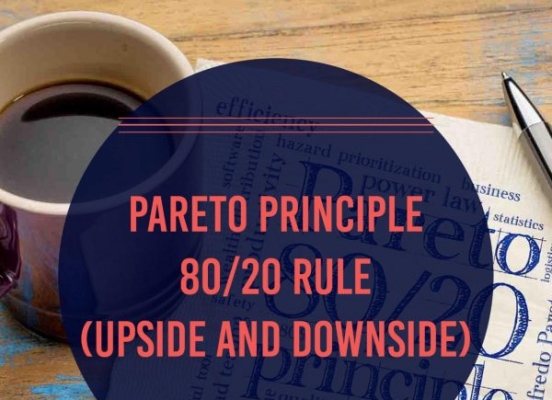
Pareto Principle – 80/20 Rule
The Pareto Principle states that 80% of consequences come from 20% of the causes, asserting an unequal relationship between inputs and outputs. It is named after the great economist Vilfredo Pareto. This principle is a general reminder that the connection between inputs and outputs isn’t balanced. The Pareto Principle is additionally referred to as the Pareto Rule or the 80/20 Rule.
APPLICATION
The Pareto Principle is often applied in a wide range of areas like manufacturing, management, and human resources. For instance, the efforts of 20% of a corporation’s staff could generate 80% of the firm’s profits. The Pareto Principle can be applied in those businesses that are client-service based. It has been adopted by many coaching and customer relationship management (CRM) software programs.
It can also be applied on a personalised level. Time management is the most ordinary use for the Pareto Principle, as most of the people tend to thinly spread out their time instead of focusing on the most important tasks. In terms of personalised time management, 80% of your work-related output could come from only 20% of your time at work.
CORE PRINCIPLE
At its core, the 80-20 rule is about identifying an entity’s best assets and using them efficiently to create maximum value. For example, a student should try to identify which parts of a textbook will create the most advantage for an upcoming exam and focus on those first. This does not suggest, however, that the student should ignore the other parts of the textbook.
Here are a few examples of the Pareto principle in action:
v20 % of a given employee’s time yields 80 % of their output.
v20 % of software bugs cause 80 % of the software’s failures.
v20 % of a company’s investments produce 80 % of its investment profits.
PARETO CHART
A Pareto chart is highly helpful for prioritising problems so that you can determine which issues have the greatest effect on the outcome of a given situation. It also enables you to take appropriate actions to resolve the most important issues concerning your business.
The looks of a Pareto chart is quite straight forward with vertical bars plotted in decreasing order in relevance to their relative frequencies. The higher the frequency, the greater the effect it will have on your business – so, it is crystal clear where you need to focus your attention on to improve your business. The Pareto chart is an excellent way to pinpoint the issues influencing your sales, productivity and overall success of the business.
THE UPSIDE OF THE 80/20 RULE
When applied to your life and work, the 80/20 Rule can help you separate “the vital few from the trivial many.”The 80/20 Rule is like a form of judo for life and work. By finding precisely the right area to apply pressure, you can get more results with less effort.
vINCREASED PROFITABILITY
The Pareto Principle suggests that a small percentage of your total amount of customers produce the majority of revenue. Similarly, only some of your products and/or services attract the most sales. As such, analysing the leads and current customers you have can help you determine which ones have produced the most revenue in the past so that you can focus on pursuing only the most valuable leads.
vINCREASED PRODUCTIVITY
The Pareto Principle teaches employees to not waste time on the immaterial goals that will not contribute to the long term goal and to focus their resources on the ‘vital few’ that will produce the majority of the results. Similarly, the Pareto Principle can be used to recognise the causes of unproductiveness in the workplace.
THE DOWNSIDE OF THE 80/20 RULE
While the 80/20 split is true for Pareto’s observation, that doesn’t necessarily mean that it is always true. The Pareto Principle is merely an observation and not necessarily a law.
vQUANTITATIVE DATA BASED
Pareto analysis bases its conclusions on quantitative data. But most decisions, particularly in regard to human and social activities, require weighing not only statistics but more qualitative issues to reach a decision.
vFOCUSES ON THE PAST
Traditional Pareto Analysis uses past data. By the time historical data, is being used, things might have changed and the results obtained may not be compatible with the current situation. The sole dependence on past information in Pareto analysis can be deceptive. Small-businesses owners may find that the past data does not precisely represent the company’s current situation.
vMISAPPLICATION
Many people simply don’t understand it. They, therefore, misuse and abuse the rule. Others have a little understanding of the rule but overzealously apply it beyond its brief. In the end, these users generalise an otherwise powerful analytical tool for getting high level “feel for things” thus giving it a bad name.





